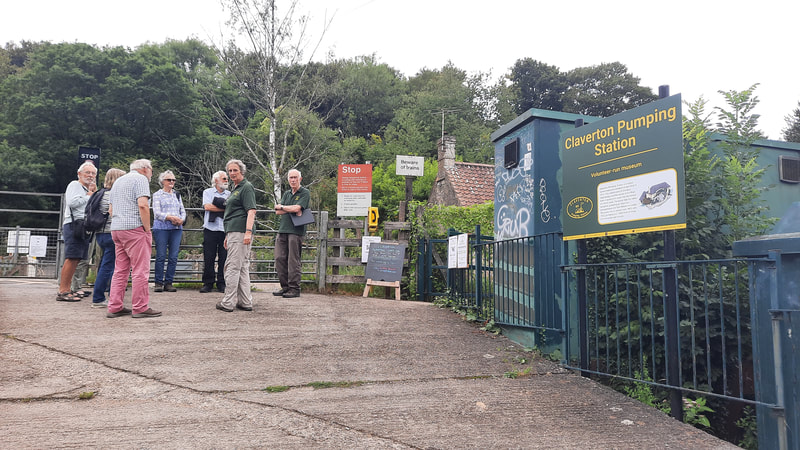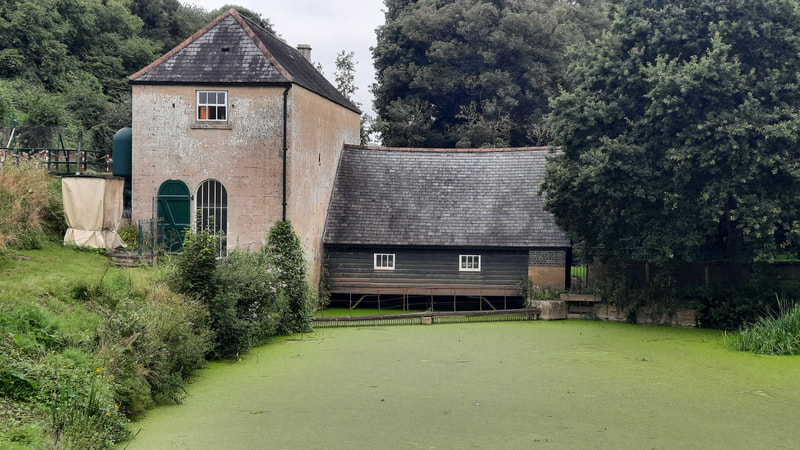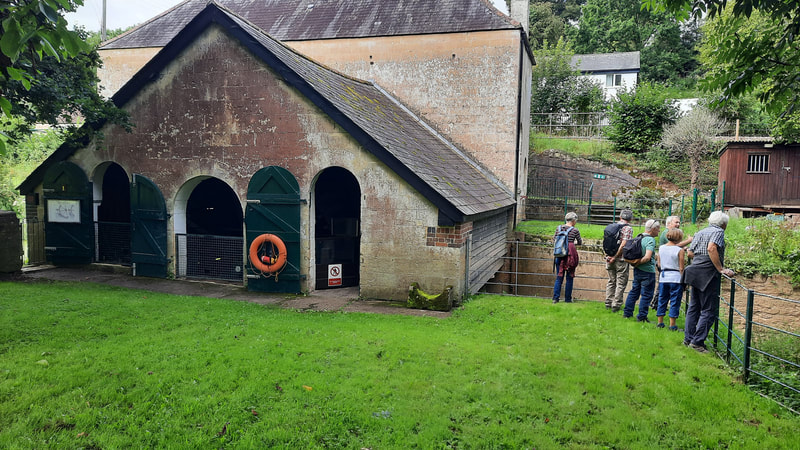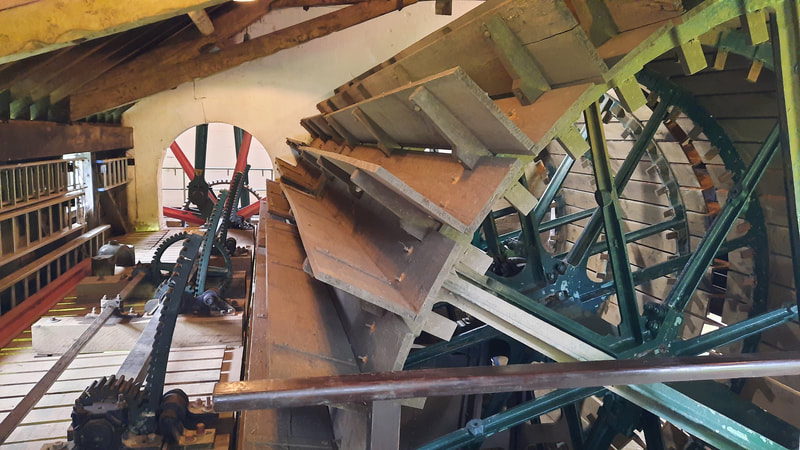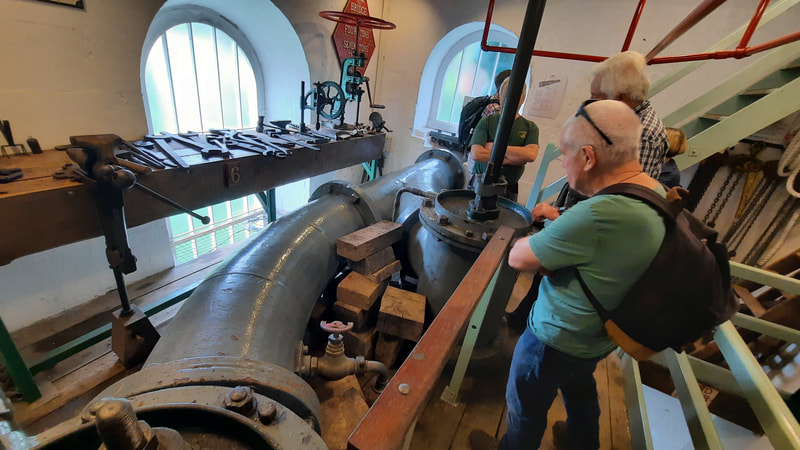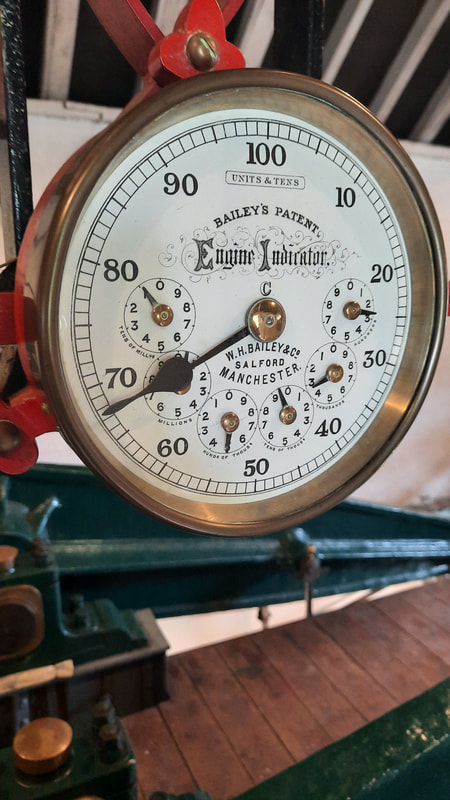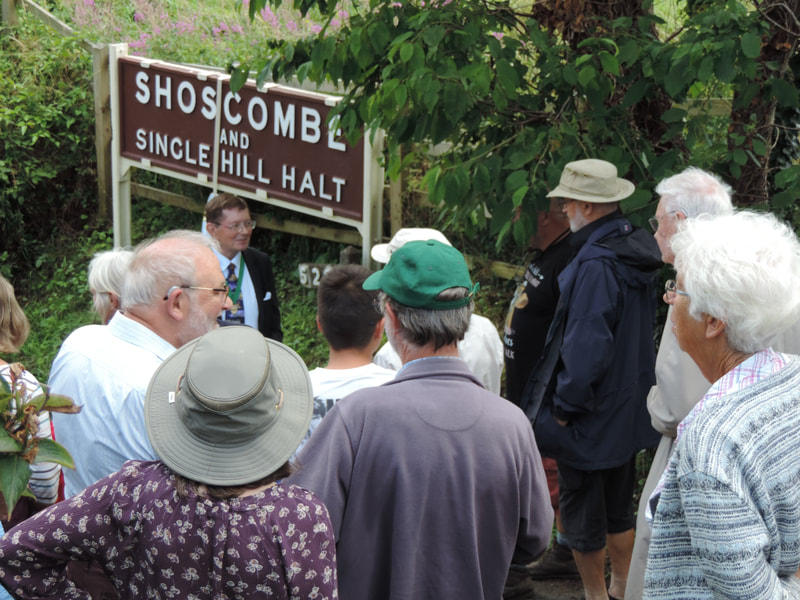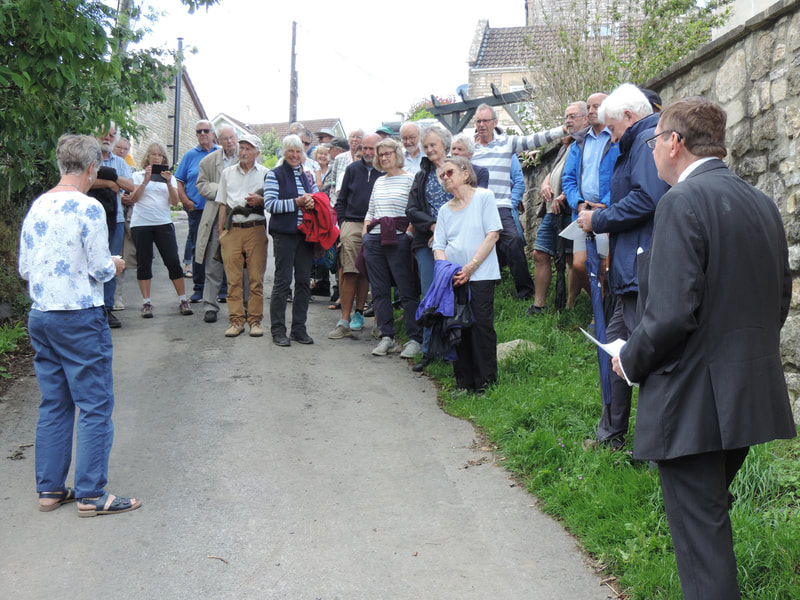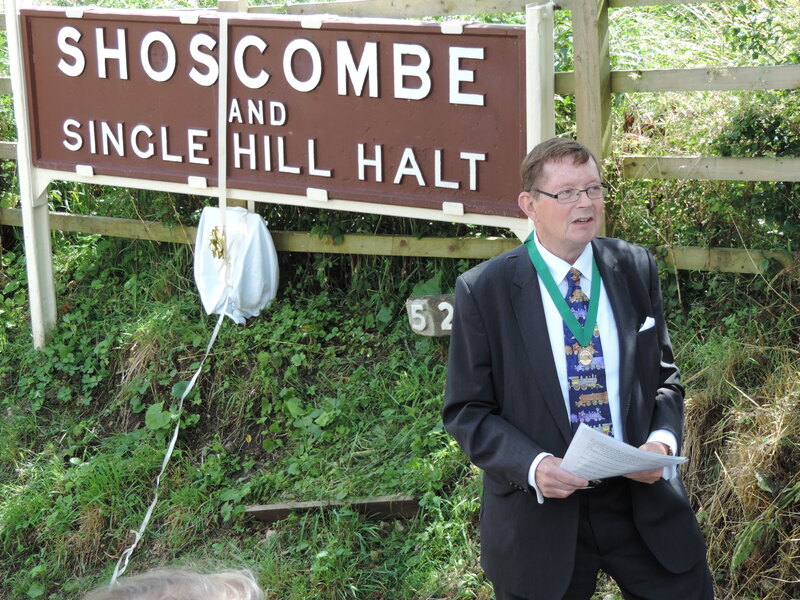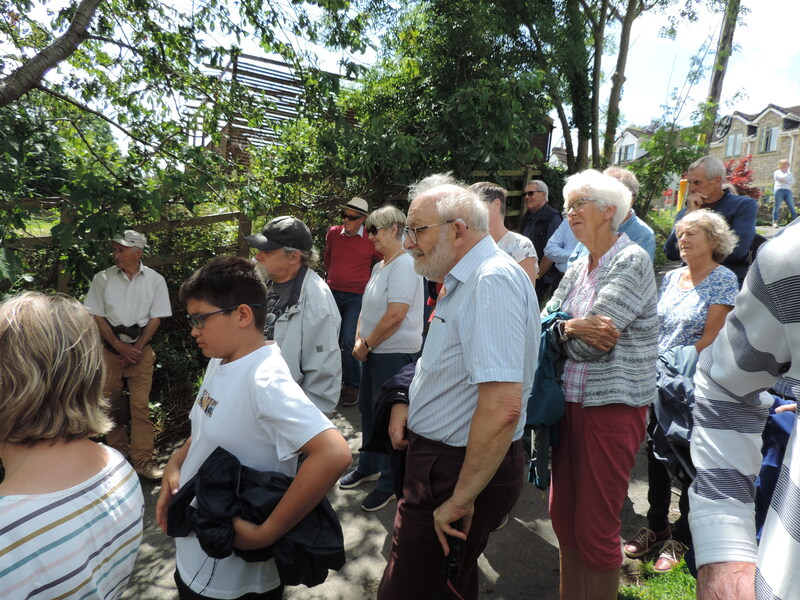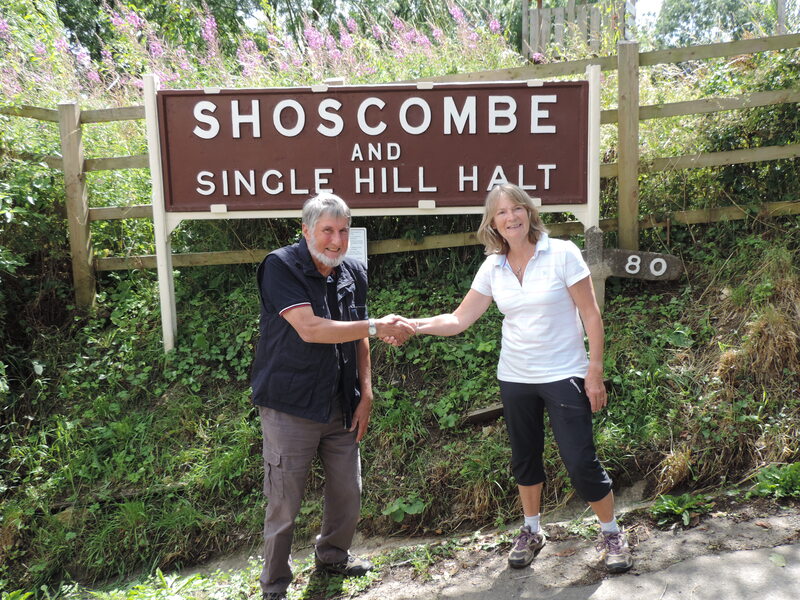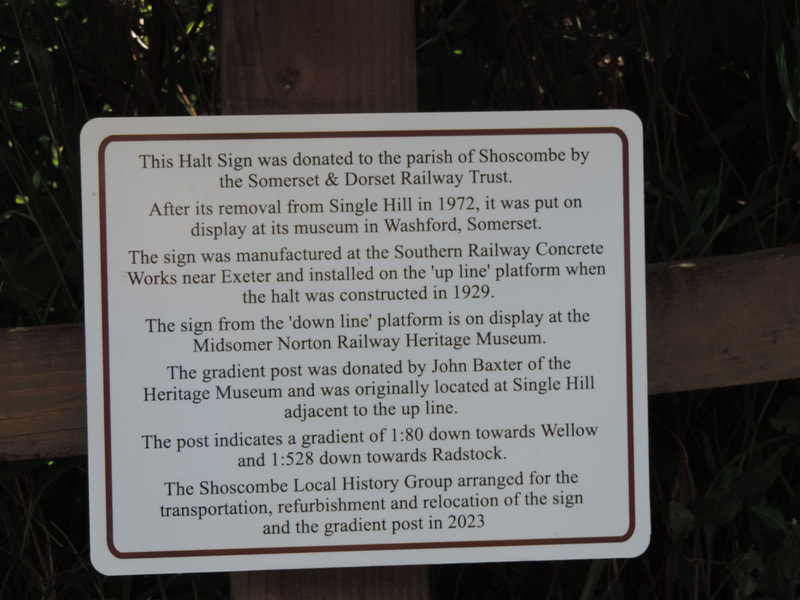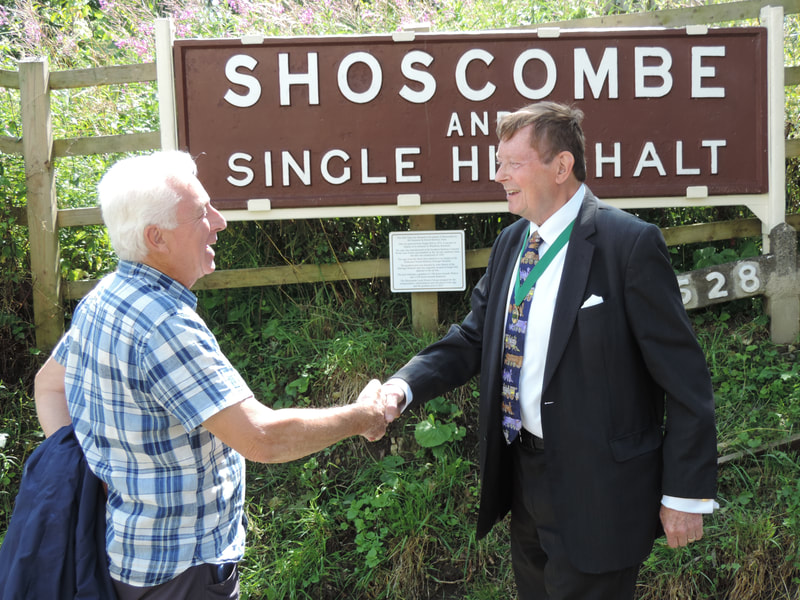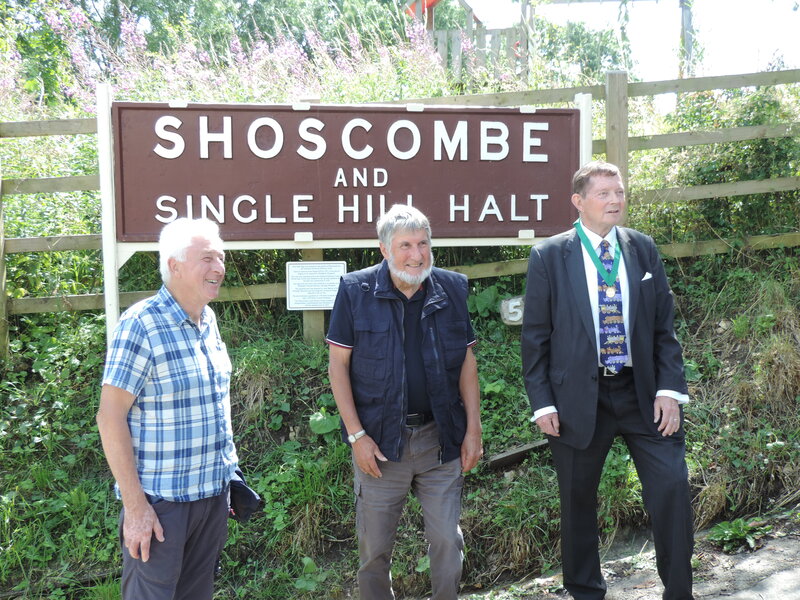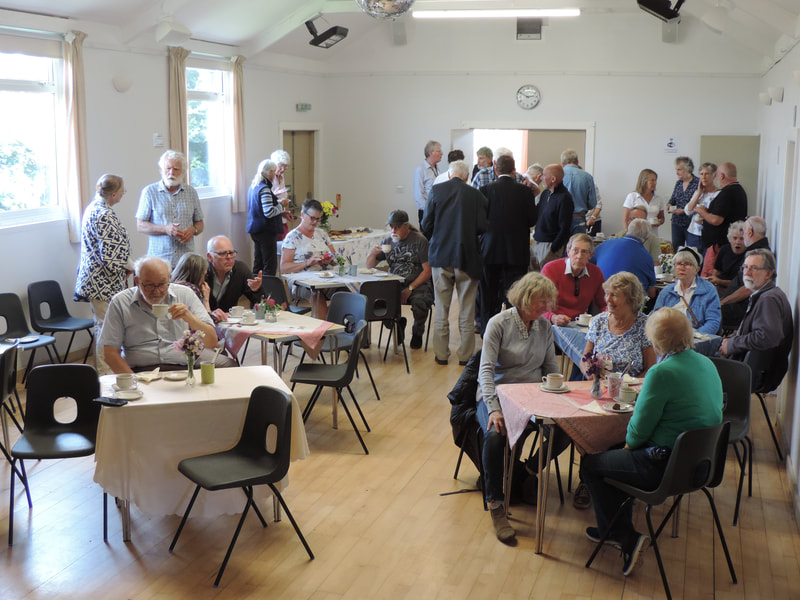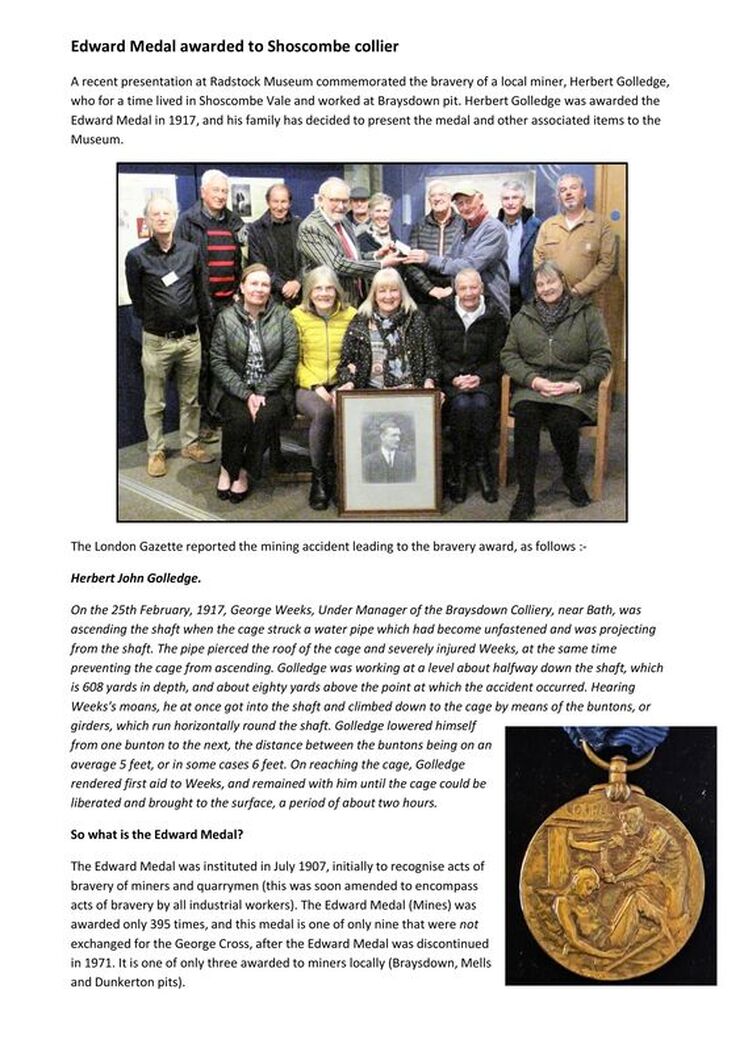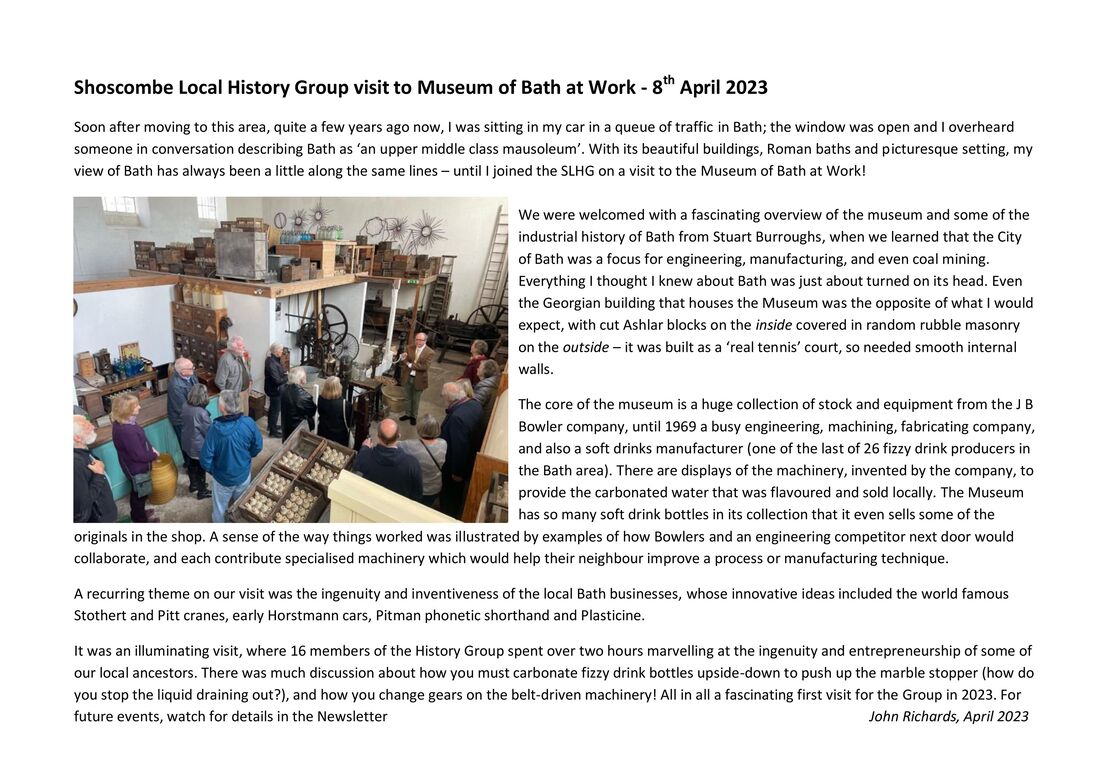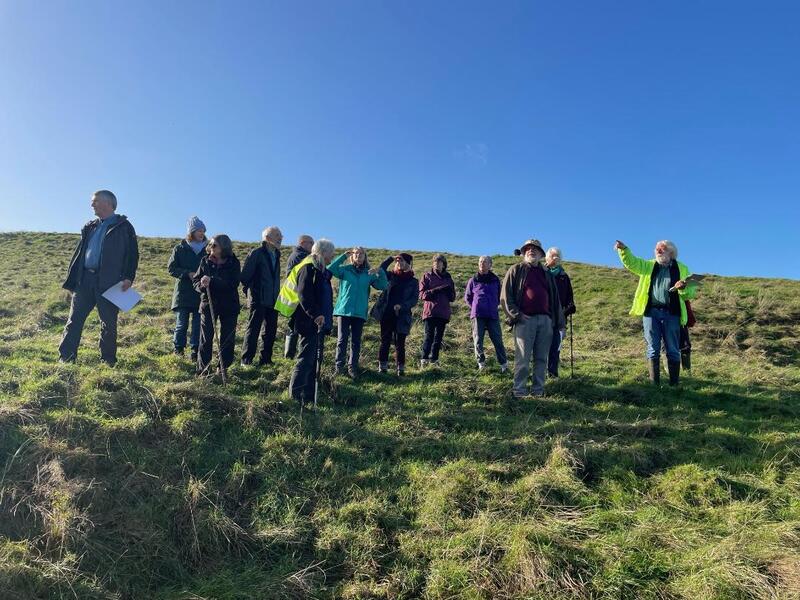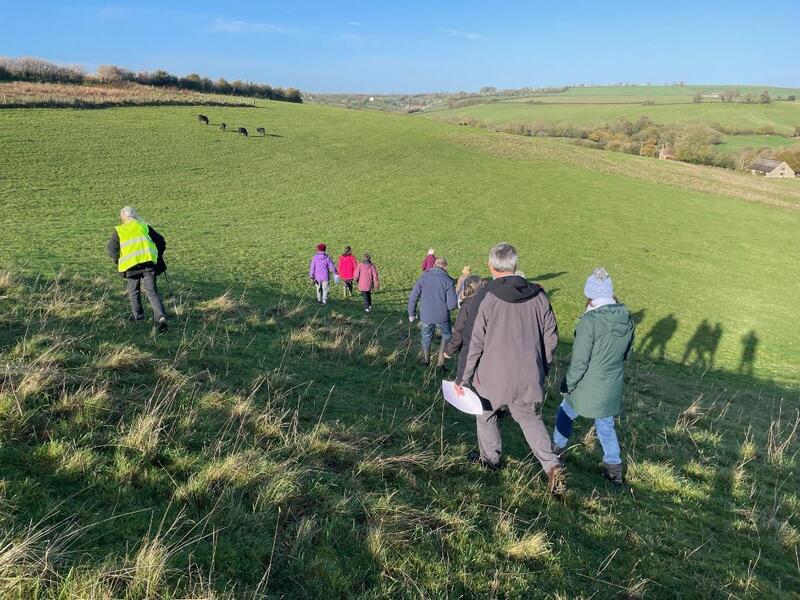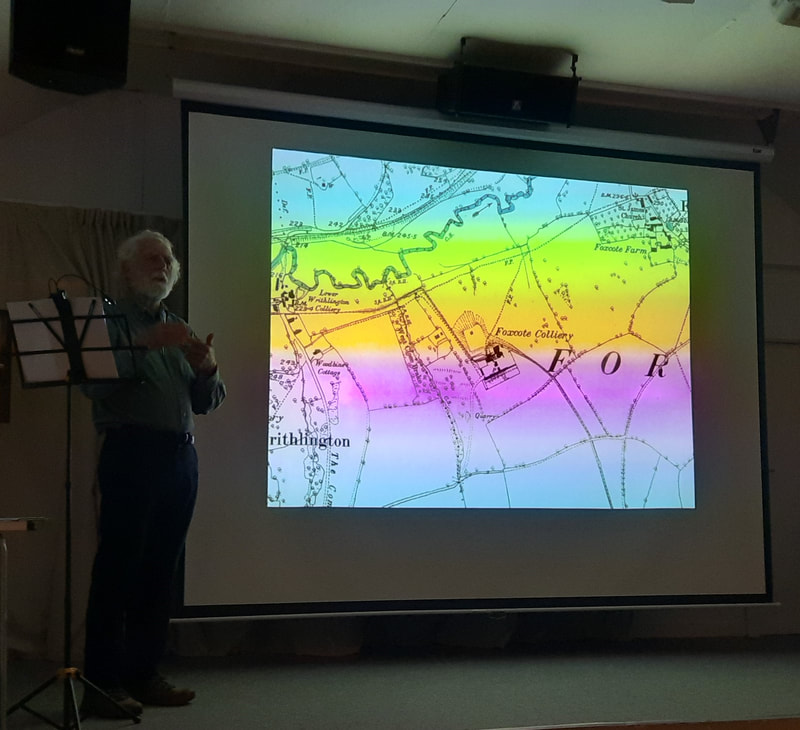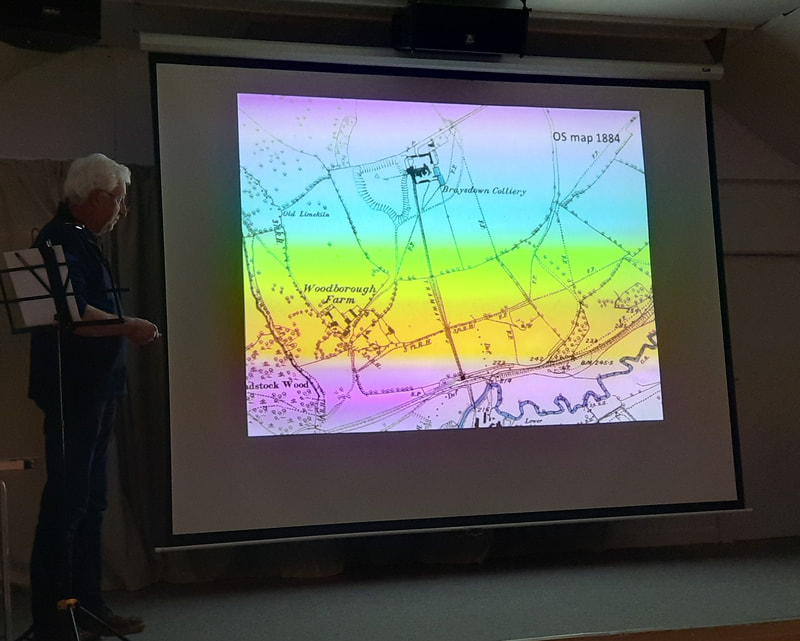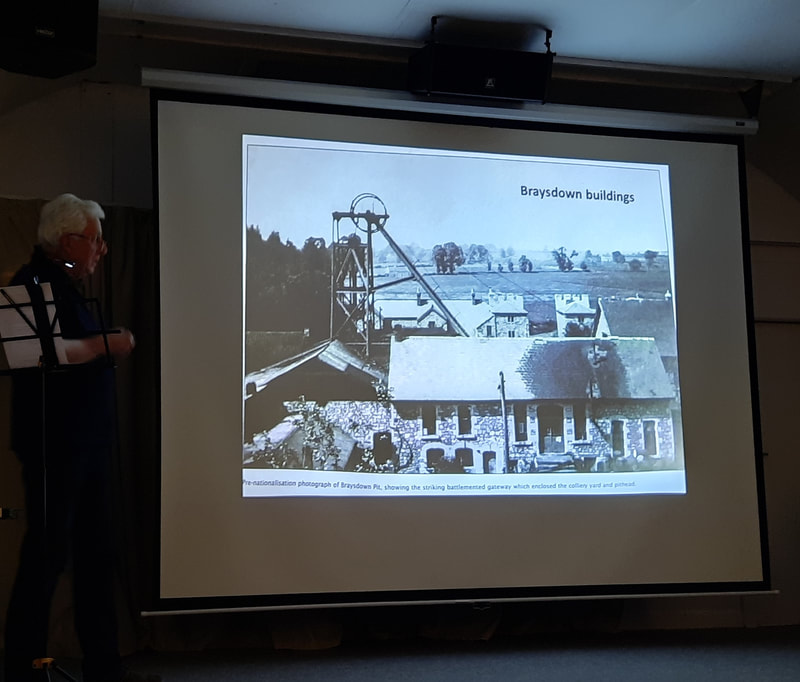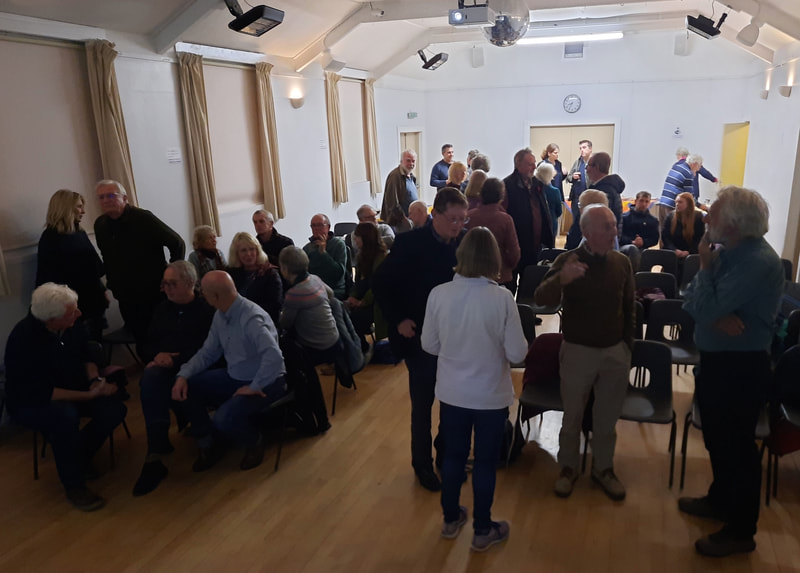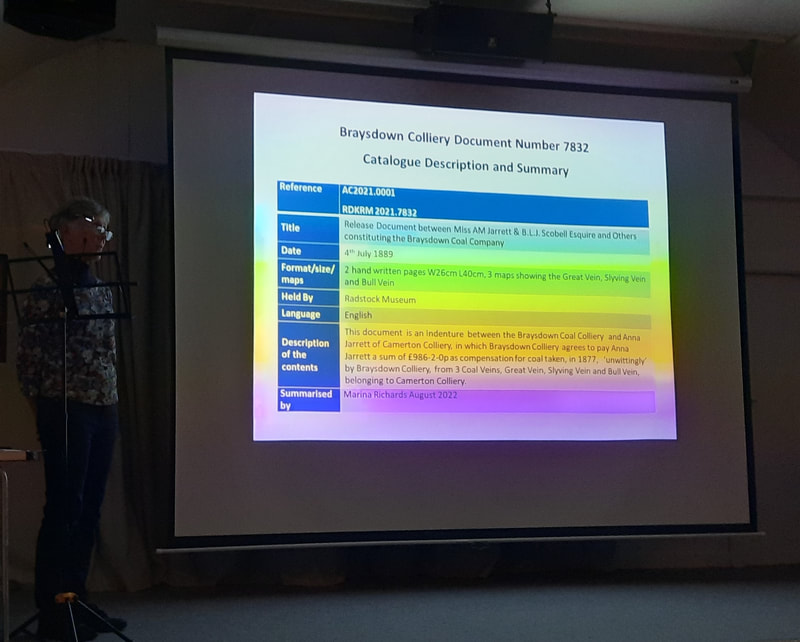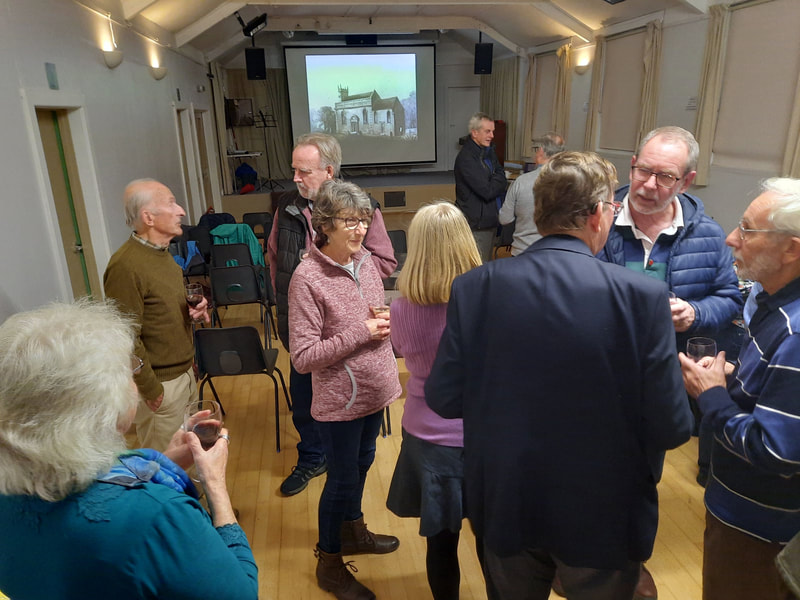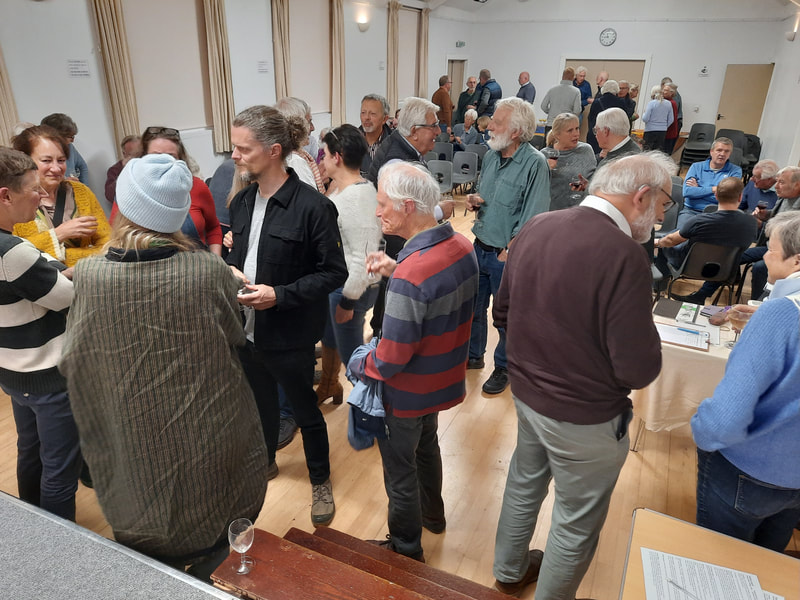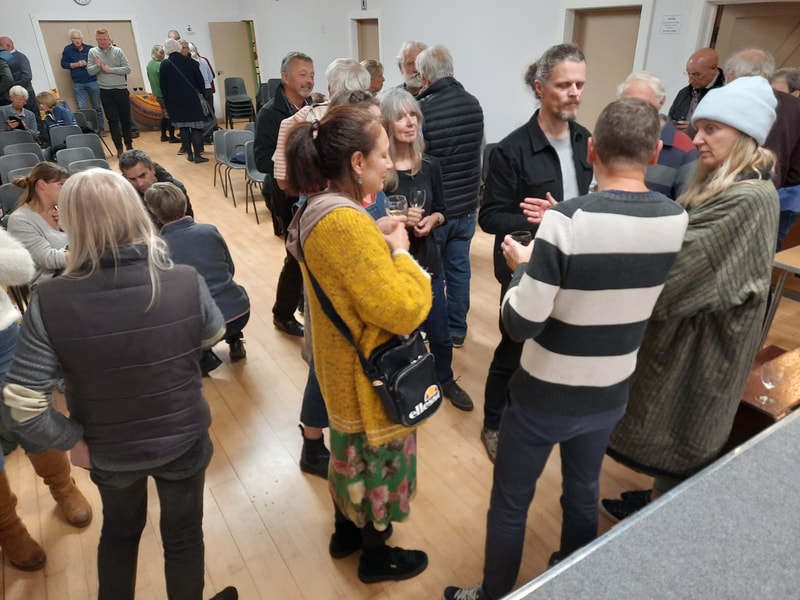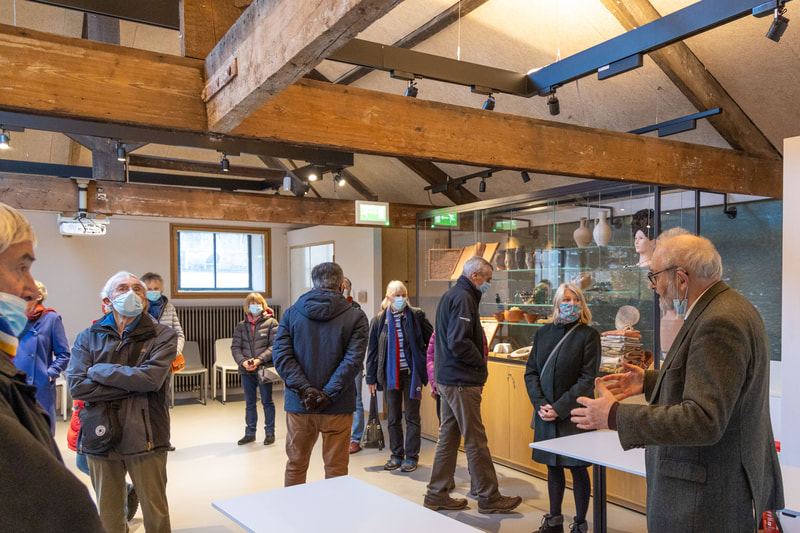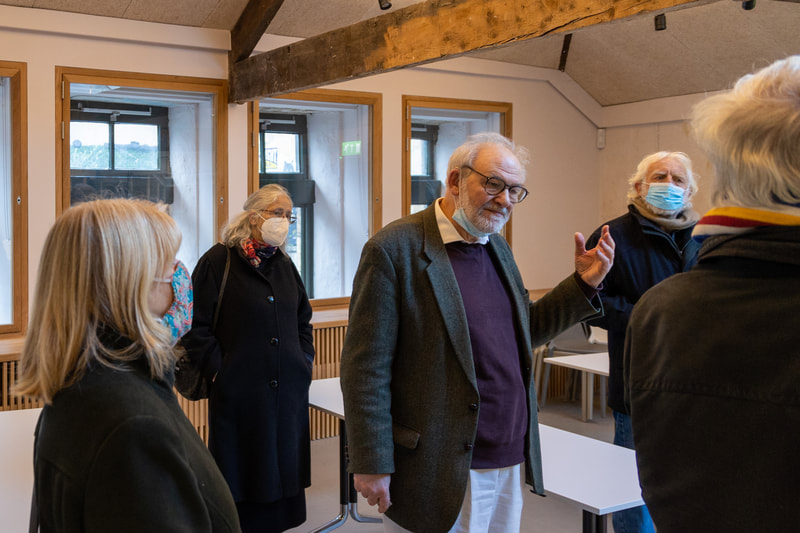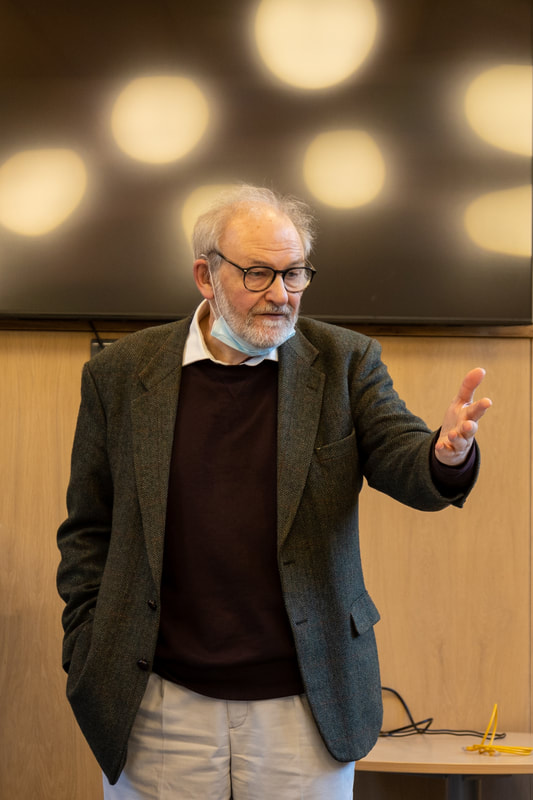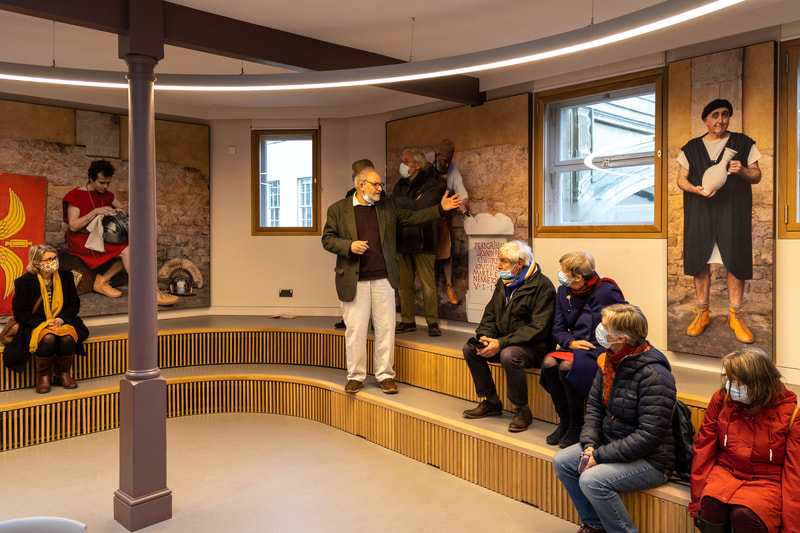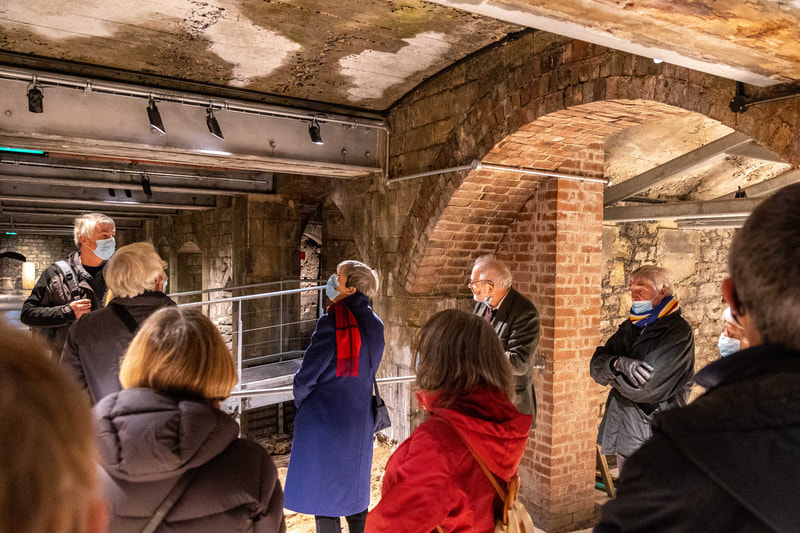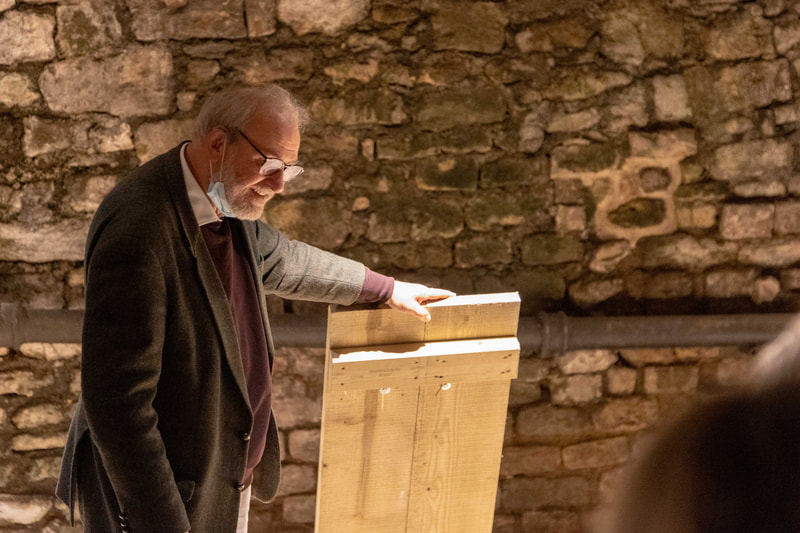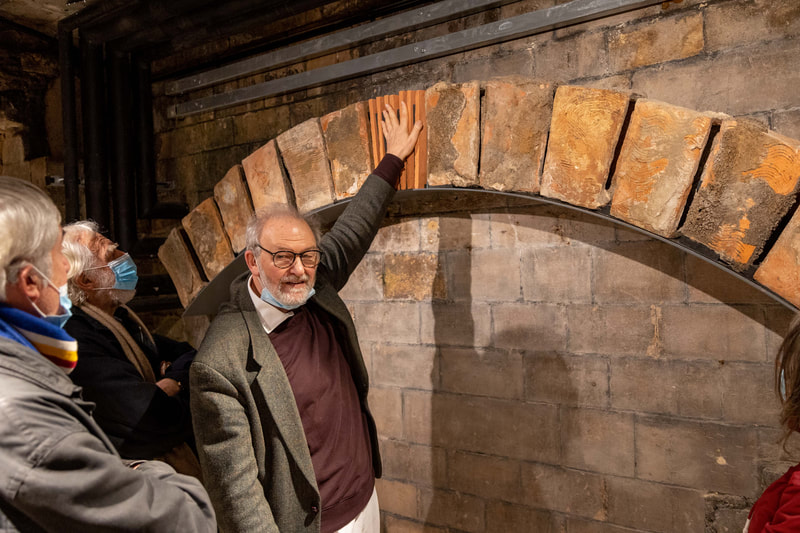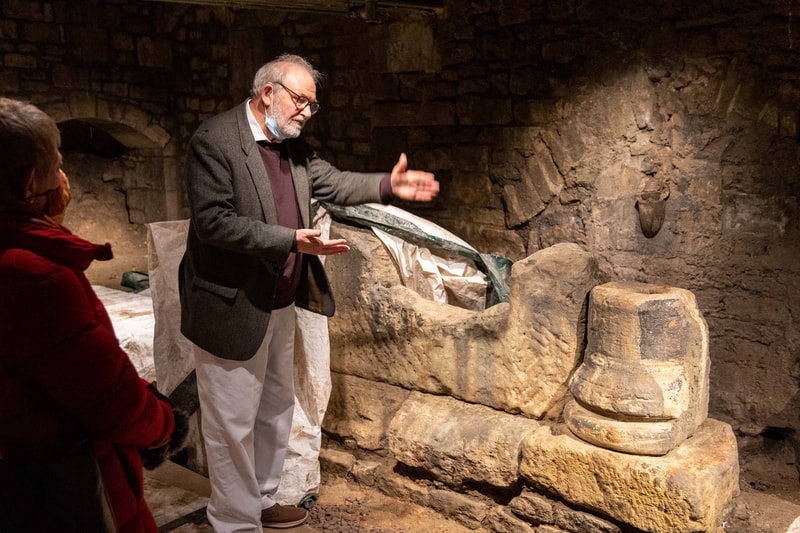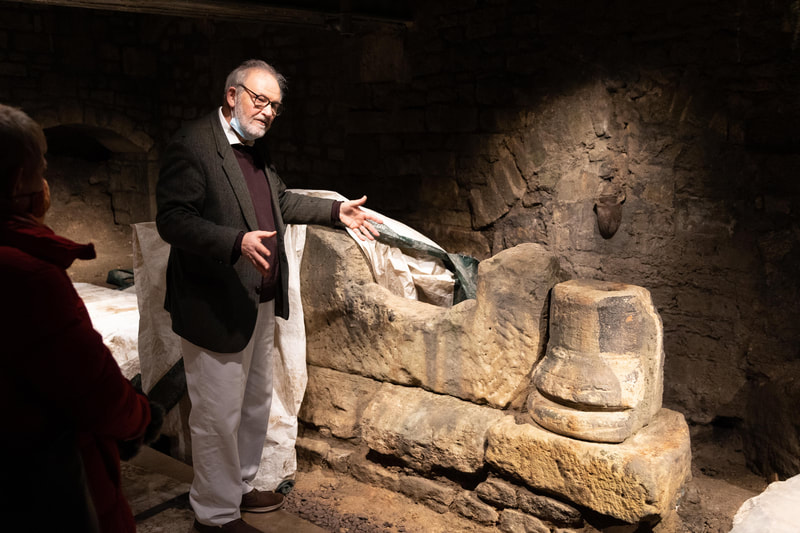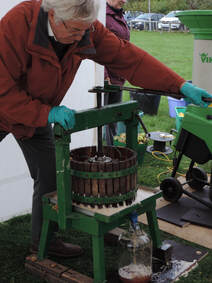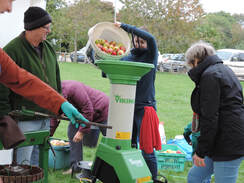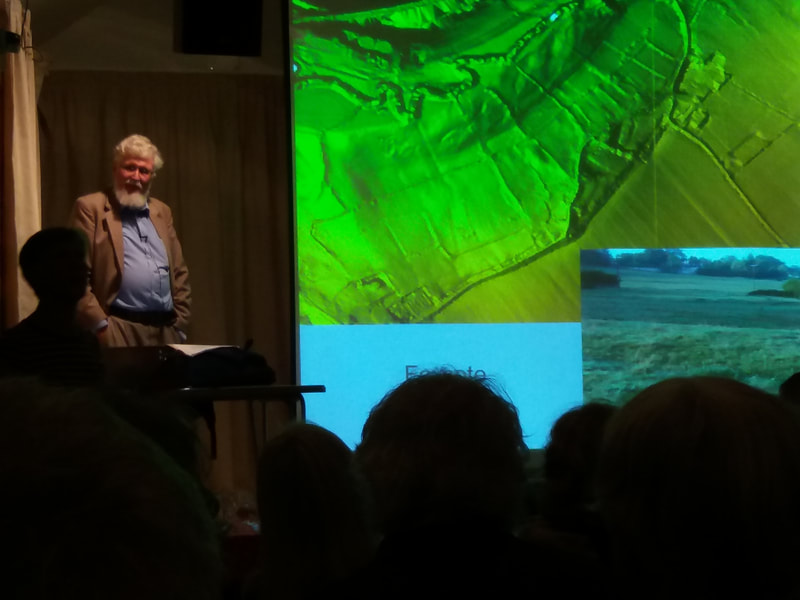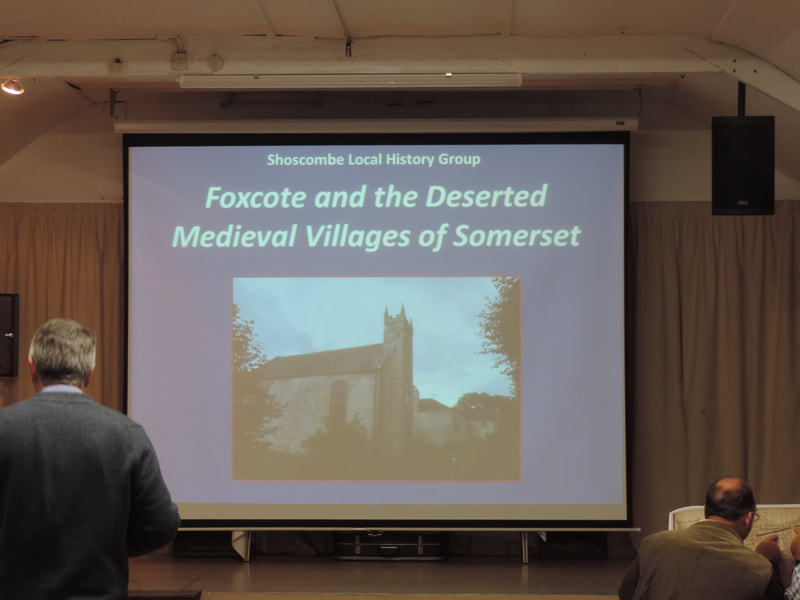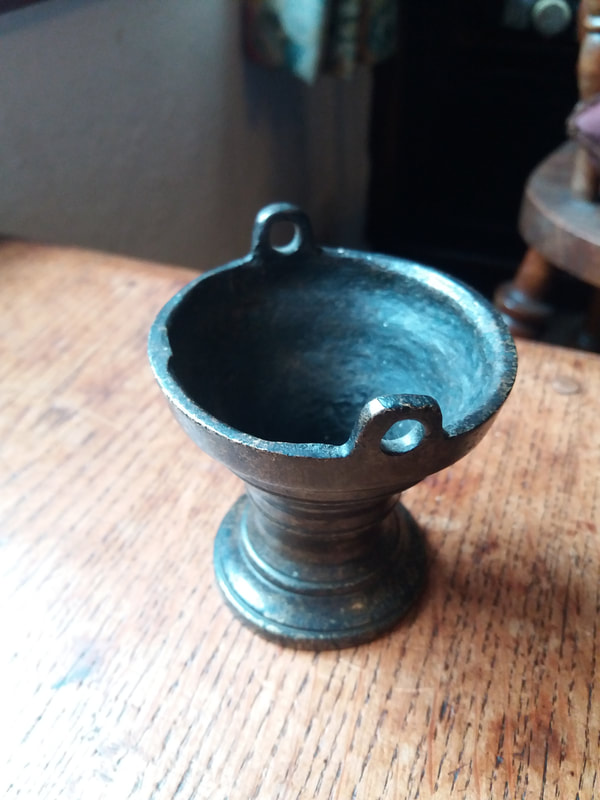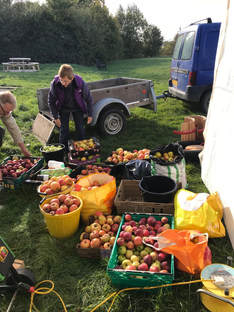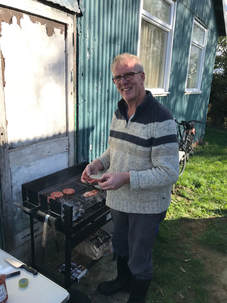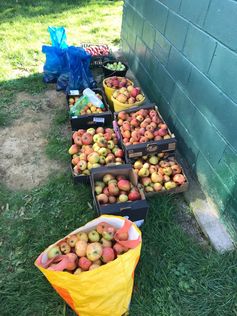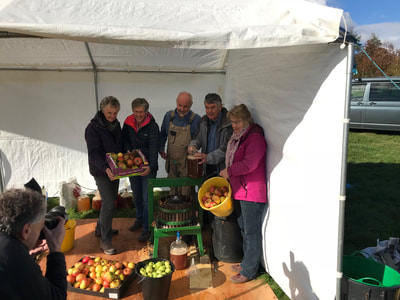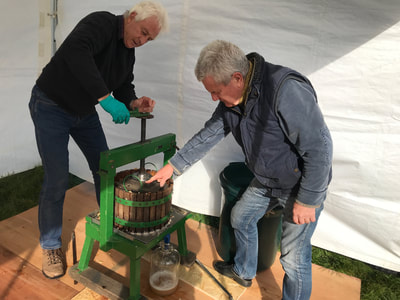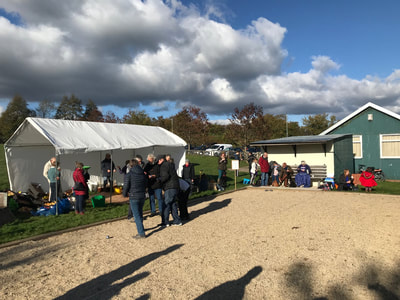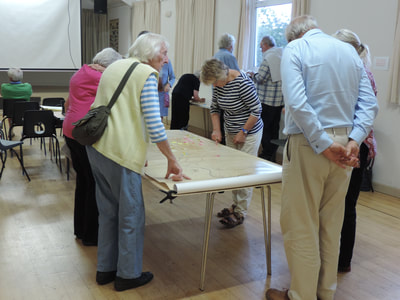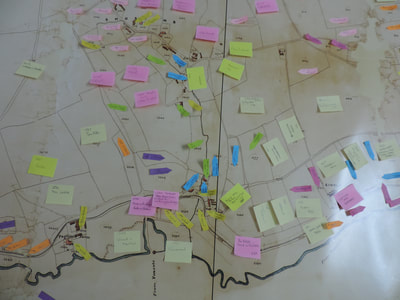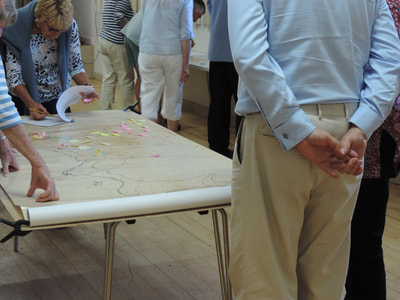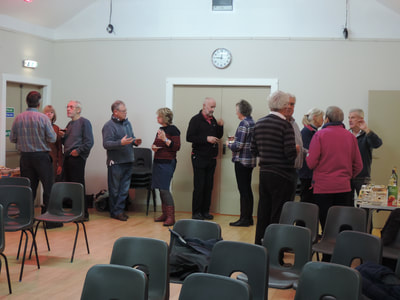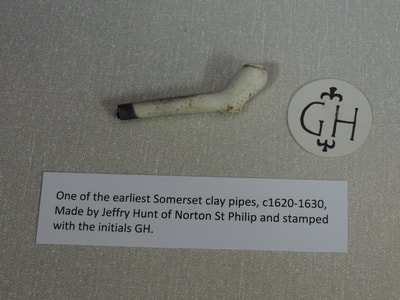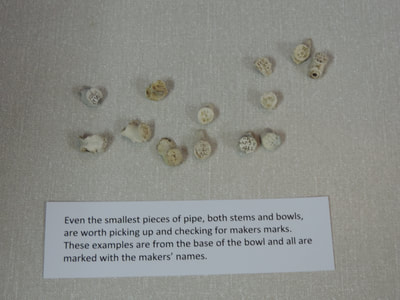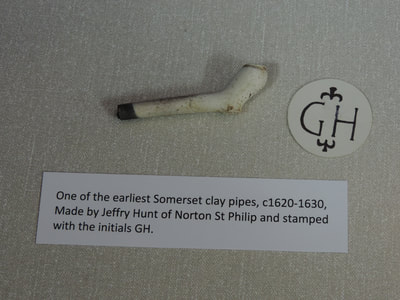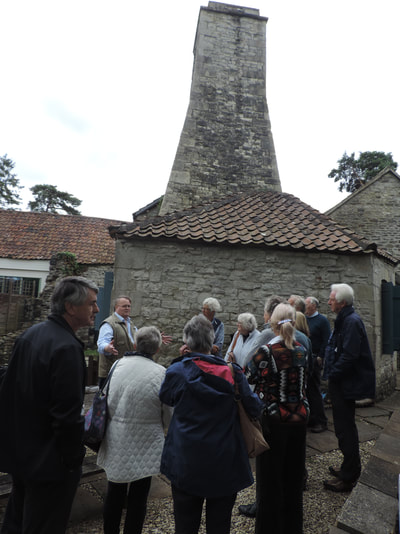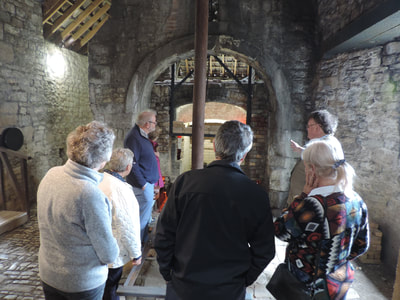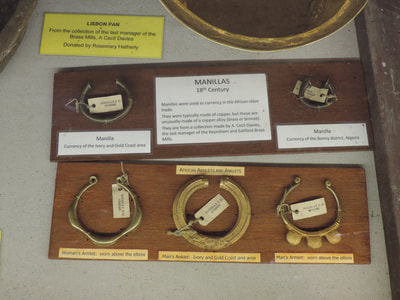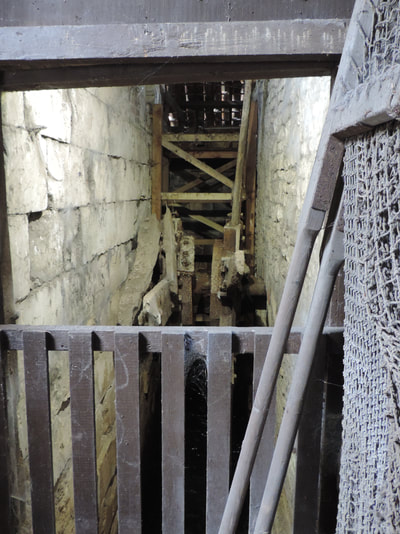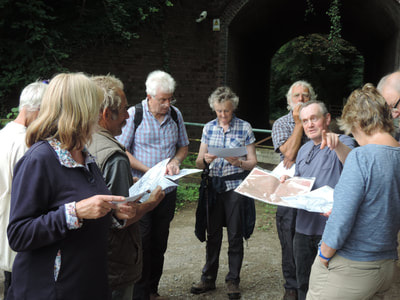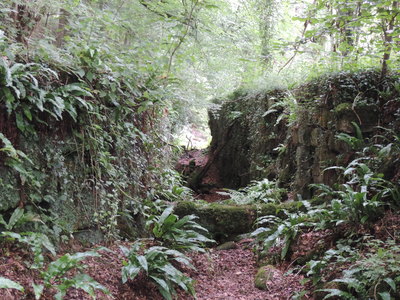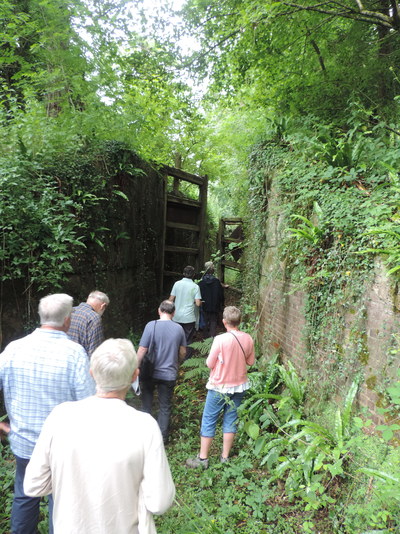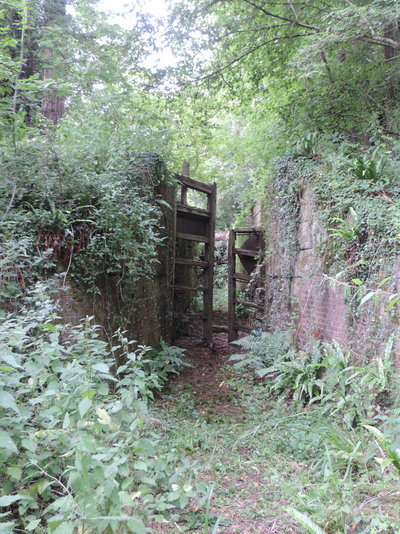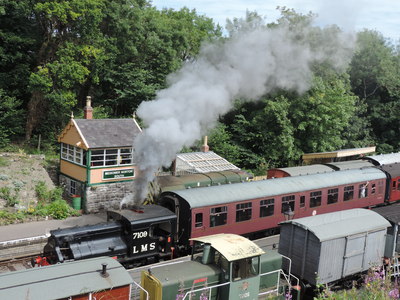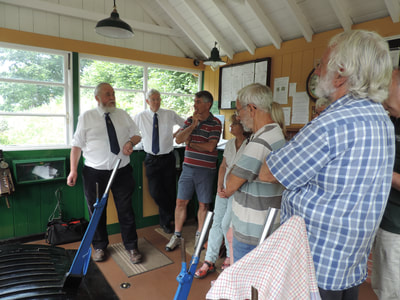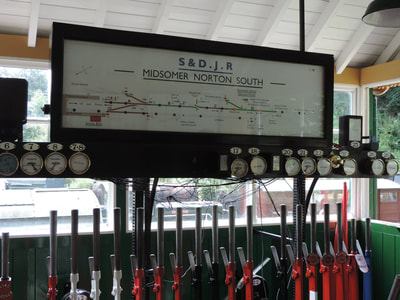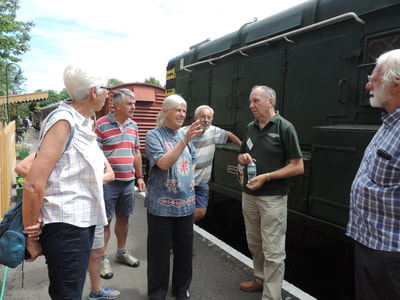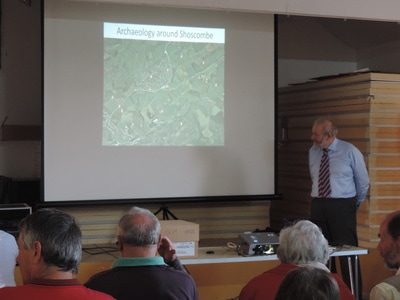Projects, Talks and Visits
Visit to Claverton Pumping Station - August 2023
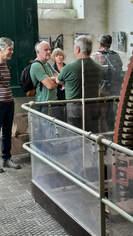
This Grade 1 listed pumping station was a fascinating site to visit, easily accessible from the Kennet and Avon Canal towpath. On a warm Saturday morning in August we were met by volunteers who explained how the pump, constructed in the Georgian Regency Period, first pumped water in 1813. The pump uses water from a leat from the River Avon to drive a massive waterwheel which then lifts water up 48 feet into the Kennet and Avon Canal. When in operation the pump could still be used to top up water levels in the canal. Unfortunately the wheel was not operating for our visit. It is hoped it will be running again soon once repairs have been completed - check their website for details if you're interested in seeing the pump in action.
Unveiling of the Restored Shoscombe and Single Hill Halt Sign,
July 2023
Originally rescued by the Somerset & Dorset Railway Trust after the closure of the Somerset & Dorset Railway, then displayed for 40 years at Washford, one of the original concrete nameboards from Shoscombe & Single Hill Halt - opened in 1929 – closed 1966 - has now been returned to Shoscombe. The refurbishment and relocation of the board has been a recent project of the Shoscombe Local History Group, spearheaded by Derek Withers, and made possible by the Trust agreeing to donate the sign to the Shoscombe community.
The formal unveiling of the sign on July 12th, together with an information board, was carried out by Hon. Alderman Neil Butters, a former councillor for Bathavon South Ward. Neil has also previously been the secretary of the Railway Heritage Committee. In his address he recalled a memorable experience of riding on the footplate on a journey into Bath Green Park Station
In addition to Shoscombe Local History Group and members of the Shoscombe community, representatives of the S&DRT and the S&D at Midsomer Norton were at the event which concluded at Shoscombe Village Hall with afternoon teas accompanied by rolling slides and videos of historical material of the S&D railway, arranged by Shoscombe Local History Group
In addition to Shoscombe Local History Group and members of the Shoscombe community, representatives of the S&DRT and the S&D at Midsomer Norton were at the event which concluded at Shoscombe Village Hall with afternoon teas accompanied by rolling slides and videos of historical material of the S&D railway, arranged by Shoscombe Local History Group
A Special Presentation at Radstock Museum in Honour of a Local Hero, April 2023
Exploring our local heritage - visiting medieval sites, November 2022
|
Although little evidence exists above ground, the outlines of early settlement in the Wellow Valley can be found. In late November, Chris Paul, who has an extensive knowledge of this area, guided us around the sites of two deserted medieval villages at Foxcote and Stony Littleton, Stony Littleton's 'Pillow Mound', a medieval construction to farm rabbits, and the site of the former mill at Stony Littleton. |
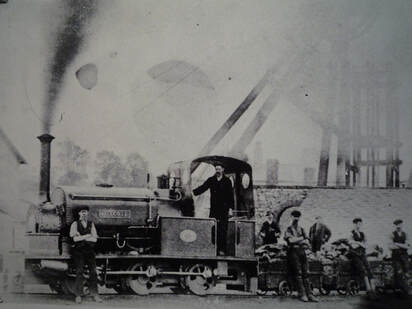
Shoscombe Local History Group – A Brief Overview of our Local Collieries
Thursday 10th November 2022 saw over 30 local villagers converge on the Shoscombe Village Hall for what promised to be a fascinating and informative evening. Inspired by Shane Gould’s excellent talk on the North Somerset Coalfield, the History Group decided to capitalise on the wealth of local knowledge to share detailed insights into our three local pits – Shoscombe, Foxcote and Braysdown.
We were welcomed by a rolling slide show of photographs of our Parish stretching back more than 100 years. They included images of people, scenes, buildings and railway memorabilia, which had those present chatting and sharing their ideas of who, where and what they were seeing.
The meeting opened with a welcome from the History Group chair, Rina Richards, who then swiftly dispensed with the formalities of the Group’s AGM to allow us to move on to the, perhaps more inspiring, illustrated talks about our local collieries. Chris Paul started things off with a brief look at how coal mining evolved in our area, before sharing maps, documents and drawings covering what little is known of Shoscombe Colliery. One of the earlier mines, Shoscombe was closed by 1860, and what little remains can be seen next to the cycle way on your way towards Radstock: look to your right to see the water-filled depression between the new picnic bench and the Railway Accident information board!
Chris then used maps, aerial images and old photographs of the pit in its heyday to show us how Foxcote developed from original lease in 1853 to its eventual closure in February 1931
Following this, Derek Withers took us on a detailed journey covering the ownership and significant milestones of Braysdown Colliery, from a map showing the mineral rights in the area, original documents of the shareholder agreement, to a chronology of the mine shown through maps and photographs. The mine is an interesting example of social history, with ownership at the start being in the hands of a few wealthy landowners, “Copartners joint dealers and Coadventures”, to the transfer of its assets to the National Coal Board over a century later. Derek concluded with photographs of the site today, and he highlighted the somewhat bizarre chronology of the closure of the mine, which happened within a year of significant investment both underground and the building of new pithead baths costing £28,000.
Rina Richards concluded the evening’s talks, highlighting some ongoing work in transcribing a number of original documents held by Radstock Museum, covering the first 60 years of the Braysdown Mining Company. There’s lots more work to be done, so if you’re interested please get in touch.
The evening concluded with cheese and wine, and a chance to chat and look again at the photographs from the Local History Group archives.
[email protected]
The North Somerset Coalfield – An illustrated talk by Shane Gould – 6th October 2022
Shoscombe Local History Group’s October’s event attracted a capacity audience of 80 to hear Shane Gould deliver a fascinating and information-packed presentation on the Somerset Coalfield.
Shane’s comprehensive knowledge of the Somerset Coalfield developed initially from listening to the memories of his grandfather, a Somerset miner, and through exploring, photographing and recording details of Somerset’s former colliery sites. This led him to undertake a degree in archaeology and then a succession of professional roles in archaeology and industrial heritage, including a position as Ancient Monuments Inspector for the SW. He is currently Head of Industrial Heritage Strategy for Historic England.
Shane illustrated his presentation with maps and photographs showing examples of the physical impact on the landscape of buildings and structures associated with the North Somerset Coalfield, such as tramways, engine houses, coke ovens and pit heaps. He explained how the geographical development of the coalfield went hand-in-hand with the development of mining technology and transport infrastructure, leading to the development of the North Somerset Coalfield in three main areas. The first area of development was in the south, around Nettlebridge and Coleford where coal seams outcrop at the surface. Accurate dating of these primitive workings is difficult, but it thought that coal from this area may have been transported to Bath along the Fosseway in Roman times.
The next significant development phase took place in the north in the early 19th century when tramways connecting to the Somerset Coal Canal enabled major mines to be opened up along the Cam Valley.
The final major development area centred on Radstock and Midsomer Norton, which was given a significant boost by the opening in 1854 of the Radstock to Frome railway, with connections to Ludlows and Tyning collieries, and subsequent opening in 1873/74 of the Bristol and North Somerset Railway and the Bath extension to the Somerset and Dorset, with an extended network of lines connecting the Radstock collieries. Annual production of the coalfield peaked at 1.25 million tonnes in the early 20th century.
Shane described technological developments from the time when shallow shafts were worked using ladders for access and manpowered windlasses or a horse gin for raising coal to the surface. Sloping adits were dug to drain mine water wherever an above-ground outlet was possible. Early pumps were often hand- or horse-driven. From the 17th century water wheels are recorded in Somerset driving more complex pumping machinery and in the 18th century steam powered pumping engines were introduced.
Deeper shafts with more extensive workings required measures to improve ventilation, both to provide fresh air for miners to breathe and to vent noxious gases such as firedamp (methane), carbon monoxide and carbon dioxide. Ideally a second shaft would be connected to the first via the underground workings, whereby fresh air could be drawn down the downcast shaft and exhausted through the upcast shaft. Circulation was achieved by means of a furnace at the foot of the upcast shaft. In the absence of a second shaft, the mine’s single shaft was divided in two using timber brattices to create a rudimentary upcast/downcast means of providing essential ventilation.
Initially steam power had been used only to drive pumping engines. The invention of cranks and flywheels to convert reciprocating motion of the steam piston to rotary motion enabled steam powered winding to be adopted. Eventually ventilation too was improved using rotary powered fans drawing air up the upcast shaft, removing the need for hazardous furnaces below ground.
By 1968, only Lower Writhlington and Kilmersdon pits remained in operation. The last production shift in a Somerset mine reached the surface at Lower Writhlington on 28 September 1973.
Finally, a footnote on Shoscombe Colliery, very little of which remains as much of its site was disturbed by the construction of the S&D Railway. The pit is believed to have had a single shaft, and a steam engine driving the winding engine and pump rods. The foundations of the engine house survive close to the abandoned railway line, now the Collier’s Way cycling and walking path, approximately 250m east of the old railway overbridge at Writhlington bottom at Grid ref ST 708 555.
Shane’s illustrated talk provoked considerable interest and was much appreciated. For those whose interest has been whetted by his talk, copies of Shane’s book “The Somerset Coalfield”, published by Somerset Industrial Archaeological Society in 1999, ISBN 0 9533539 0 7, are available for purchase at Radstock Museum.
Nigel Nott
Visit to the Archway Project Bath, Sunday 5 December 2021
It was a great privilege for the Shoscombe Local History Group to be taken on a pre-opening tour of Bath’s new Archway Project on Sunday 5 December 2021 by Stephen Clews, Roman Baths Manager. Stephen provided expert commentary on all aspects of the Archway Project development in which he has played a key role since its inception as B&NES Project Lead. A very great deal has been achieved since the History Group previously visited the Roman Baths in February 2018, when the initial exploratory archaeological investigations for the project had just begun.
The Archway Project comprises two major facilities: the City of Bath World Heritage Centre at 10 York Street, and the state-of-the-art Roman Baths Clore Learning Centre above the former City Laundry, boiler house and old spa workshop in Swallow Street. Taking its name from the ornate archway over York Street that once carried hot spa water between the boiler house and the Baths complex, the Archway Project opens officially in Spring 2022.
The new World Heritage Centre is conceived as a starting point for visitors of all ages to learn about the city and then go out, better informed, to explore the city and its heritage. Information boards and interactive displays within the Centre showcase four key themes of Bath as a UNESCO World Heritage Site: hot springs, Roman archaeology, Georgian architecture, and the built form of the compact city set within a hollow-in-the-hills landscape. The project has developed the “Bath World Heritage App”, which is available for free download for iOS and Android mobile devices, to complement information provided within the World Heritage Centre and to enable visitors to navigate the heritage assets of the city on foot.
During our tour of the Roman Baths Learning Centre Stephen provided many fascinating insights, drawn from his deep understanding and knowledge of all aspects of the project, including:
- The process of developing the scheme concept and attracting funding from the National Lottery Heritage Fund, B&NES, the Clore Duffield Foundation, and other sources, totalling £6M;
- The findings of the pre-construction archaeological excavations beneath the vaults under York Street, which revealed Roman floors and likely evidence of an exercise area outside the original covered bath complex;
- How discovery of severe corrosion within beams supporting York Street required an immediate road closure on highway safety grounds followed by engineering investigations, design and installation of new long term remedial and strengthening measures;
- How, early in the construction phase, Roman masonry blocks were temporarily removed from the vaults to a store in Keynsham, where they were 3-D scanned to facilitate subsequent “virtual reconstruction”, prior to being reinstated on site when redevelopment work was sufficiently advanced;
- The role played by consultations with a wide range of stakeholders, including schools, to tap into their aspirations and to ensure the completed project would meet their needs;
- The way in which engineering and architectural issues were addressed by the client team and Bath-based lead designer Feilden Clegg Bradley Studios to provide a structurally stable and fully accessible building across three floors and an underground level;
The inspiring Learning Centre, finished to a very high standard, will enable an estimated 25,000 learners per year to participate in educational visits, making use of its flexible spaces for discussions, practical demonstrations, handling artifacts and taking lunch, complemented by fully accessible toilet and cloakroom facilities. In the Discovery Zone learners can particate in simulated archaeological digs, build roof arches like the Romans did, examine archaeological finds, learn about Roman masonry handling techniques and use iPad technology to capture images of Roman masonry blocks and reconfigure them in virtual space.
The information-packed two-hour visit left vivid impressions of the centuries of cultural heritage that we are fortunate to enjoy locally in the UNESCO World Heritage Site that is the City of Bath. The visit was also a reminder of the way in which the original Roman site has been renewed, extended and reinterpreted by different generations over the years.
The visionary concept of the Archway Project, its detailed design and meticulous execution create a valuable addition to the educational and cultural assets of our city. The completed project is a credit to all those who have been instrumental in making it happen; our congratulations go to the whole team and particularly to Stephen for his key part in the project, together with our thanks for hosting an exceptionally stimulating visit.
Nigel Nott, December 2021
Projects, Talks and Visits in 2019
Foxcote and the Deserted Villages of Somerset, Friday 11th October
There was a capacity audience in Shoscombe Village Hall for an illustrated talk by James Bond. He shared with us his vast knowledge of three key aspects of deserted villages :-
- How to identify them from landscape features, aerial photos and written records, with many examples of each of these.
- The reasons why villages disappeared. Probably the most common reason for abandoned villages is population decline caused by a combination of climate changes in the early 14th century, which brought repeated crop failures leading to famine, and at the same time, repeated outbreaks of the Black Death. As a result between a third and a half of the entire population of England lost their lives. This led to labour shortages, particularly on marginal farmland, as farm labourers could move onto empty land and properties in more productive areas. Through the late 14th and 15th centuries many landowners, deprived of a sufficient labour force for agriculture and suffering lapsed rents, eventually resorted to evicting the remaining peasants and converting their land to enclosed pasture.
- Research sources that can help us identify deserted villages, from the Domesday Book and a huge range of civil and religious records, to changes in place names.
Our only disappointment was that James, in his quest to share a lifetime of first-hand research into the subject, left specific mention of Foxcote to the end, so could not go into great detail because of lack of time.
However, the good news! He has sent us a ten-page study of the history of Foxcote, with population figures, detailed source quotations and other material that gives some clues and sources for further research. If you would like a copy, please contact Rina Richards 01761 434357 / [email protected]
Finally, a further highlight of the evening was a hands-on display of mediaeval and historic artefacts belonging to Bob Freeman, who fascinated us with his detailed explanations of these articles, their origins and how they were used.
Projects, Talks and Visits in 2018
Apple Day October 2018
Many thanks to all those who helped make this a successful occasion. There were plenty of apples to chip and press and litres of juice juice to make into cider.
There was a great BBQ and a boules tournament with our neighbours from Wellow.
September's guided walk along the Somerset Coal Canal with Roger Halse
August's Field Names Workshop
The workshop began with an informative talk about the history of field names from Chris Paul. Field names were then added to a copy of the 1846 Tithe Map to build up our knowledge of the historic land use in the parish.
Projects, Talks and Visits in 2017
Shoscombe Local History Group's AGM and Talk on the History of Clay Pipes
“A pint and a pipe” was the order of the day in many pubs during the 18th and 19th centuries, and the history of the making of these clay pipes was the theme of Marek Lewcun’s talk in the Village Hall on Monday 20th November. With Norton St Philip an early manufacturing site there were many local examples on display, and Marek was also able to date some pipes brought along to the hall by local residents. Marek finished his talk showing some photos of the Saw Close excavation which unearthed the remains of two pipe kilns on the site of the former pipe factory which lay below the former Bluecoat School’s playground.
“A pint and a pipe” was the order of the day in many pubs during the 18th and 19th centuries, and the history of the making of these clay pipes was the theme of Marek Lewcun’s talk in the Village Hall on Monday 20th November. With Norton St Philip an early manufacturing site there were many local examples on display, and Marek was also able to date some pipes brought along to the hall by local residents. Marek finished his talk showing some photos of the Saw Close excavation which unearthed the remains of two pipe kilns on the site of the former pipe factory which lay below the former Bluecoat School’s playground.
Shoscombe Local History Group’s Visit to Saltford Brass Mill on 12th August 2017
A group of local enthusiasts spent an enjoyable morning exploring the fascinating old Brass Mill at Saltford. Informative guides helped to explain the history of the mill and its importance to the local economy, linking the products made in Saltford with the infamous Slave Trade with West Africa and North America. Using the River Avon for both power and transport, it produced ‘battered’ brass pots, then wire and finally pins. The importance of the mill could be judged from the fact that 5 water wheels operated on the site, although only one remains in working order today. Brass-making at Saltford finished in 1928; today the mill is both a Grade II listed building and a Scheduled Ancient Monument.
A group of local enthusiasts spent an enjoyable morning exploring the fascinating old Brass Mill at Saltford. Informative guides helped to explain the history of the mill and its importance to the local economy, linking the products made in Saltford with the infamous Slave Trade with West Africa and North America. Using the River Avon for both power and transport, it produced ‘battered’ brass pots, then wire and finally pins. The importance of the mill could be judged from the fact that 5 water wheels operated on the site, although only one remains in working order today. Brass-making at Saltford finished in 1928; today the mill is both a Grade II listed building and a Scheduled Ancient Monument.
Visit to Combe Hay Locks
Shoscombe Local History Group visit to Combe Hay Locks, 16th July 2017
Shoscombe History Group teamed up with Shoscombe Ramblers for a guided walk along the route of the Somerset Coal Canal’s flight of locks at Combe Hay. The group was lucky to be shown the locks by Roger Halse, a member of the Somersetshire Coal Canal Society who has a detailed knowledge of the history and route of the canal, and who had secured permission from private land owners to show us most of the 16 disused locks. In addition the group saw the site of the Caisson lock and inclined plane, both of which preceded the building of the flight of locks; the engineering skill required without the use of modern machinery was truly impressive. The History Group is looking forward to welcoming a wide audience to hear more about the canal when, on October 20th, Roger returns to share more of his knowledge, maps and items of interest at Shoscombe Village Hall.
Shoscombe History Group teamed up with Shoscombe Ramblers for a guided walk along the route of the Somerset Coal Canal’s flight of locks at Combe Hay. The group was lucky to be shown the locks by Roger Halse, a member of the Somersetshire Coal Canal Society who has a detailed knowledge of the history and route of the canal, and who had secured permission from private land owners to show us most of the 16 disused locks. In addition the group saw the site of the Caisson lock and inclined plane, both of which preceded the building of the flight of locks; the engineering skill required without the use of modern machinery was truly impressive. The History Group is looking forward to welcoming a wide audience to hear more about the canal when, on October 20th, Roger returns to share more of his knowledge, maps and items of interest at Shoscombe Village Hall.
Visit to Midsomer Norton Station
Shoscombe Local History Group visit to Midsomer Norton Station, 8th July 2017
The 50th anniversary of the closure of the Somerset and Dorset Railway in 2016 rekindled the interest of the Shoscombe Local History Group in their local railway heritage. To find out more about how this local iconic railway is being preserved, members of the group visited Midsomer Norton Station South in July when not only were they given a guided tour of the site but were also privileged to see steam trains running again. The highlight for many was the visit to the signal box where informative volunteers explained how the interlocking system of levers ensured safe running of the trains into and out of the station.
The 50th anniversary of the closure of the Somerset and Dorset Railway in 2016 rekindled the interest of the Shoscombe Local History Group in their local railway heritage. To find out more about how this local iconic railway is being preserved, members of the group visited Midsomer Norton Station South in July when not only were they given a guided tour of the site but were also privileged to see steam trains running again. The highlight for many was the visit to the signal box where informative volunteers explained how the interlocking system of levers ensured safe running of the trains into and out of the station.
